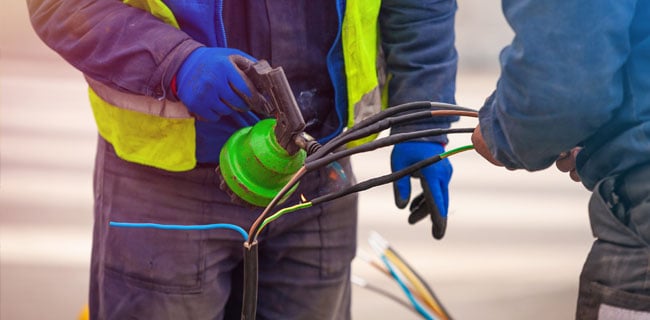Heat shrink tubing is also known as heat shrink or heat shrink protection and is a common option for securing wire and electrical connections. Heat shrink tubing is rated by its expansion ratio, which is the comparison of the material expansion and recovery rate. This ratio helps you choose the right shrinkable tubing for the parts and connections you need to cover.
How do you use heat shrink tubing?
Often made from materials like nylon, polyolefin, PVC, neoprene or a silicon elastomer, heat shrink tubing is placed over wires prior to them being connected. Before the wire connection is complete the tubing, or sleeve, is slipped over the connection. Once the wires are securely connected, the heat shrink is heated, either with a hot air gun or other heat source, causing the tubing to shrink and form a secure bond over the wires.
CONTACT US TODAY TO DISCUSS YOUR NEEDS OR TO SCHEDULE AN ONSITE CONSULTATION AT 314-638-6500 OPTION 4.
What is heat shrink tubing used for?
Heat shrink tubing has many uses and is commonly used in applications where other forms of insulation are unattainable. Not only does heat shrink tubing reinforce connections, it also provides a secure insulative layer, protecting the connection from abrasion and damage. It can be used to protect against the transfer of energy and is durable against dust, solvents and other foreign material that could compromise the connection.
Since heat shrink wrap is available in many colors, you can bundle connections for easy identification and organization. Heat shrink tubing has even been used to protect small parts from damage and abrasion. Other uses include:
- Abrasion resistance for wire connections
- Environmental protection for stranded and solid wire connections in electrical work
- Wire insulation repair
- Create cable entry seals
Related: Delivery Times are Critical to Your Success… And Ours
Consider Environment and Conditions for Proper Heat Shrink Tube Selection
Choosing the right heat shrink tubing for your electrical connections requires a thorough examination of the connection’s present and future working conditions. Will your connection need protection from the following conditions?
- Exposure to heat or cold
- Exposure to sun, rain, snow or wind
- Potential for abrasion or flexing
- Exposure to contaminants like oil, chemicals or grease
- Exposure to moisture
- Exposure to fire or arc flash
Once you identify the environmental exposure your heat shrink tubing will be subjected to you must consider related industry standards. For some jobs, you may need to meet some application-specific regulations governed by:
- UL (Underwriters Laboratories)
- CSA (Canadian Standards Association)
- ASTM (American Society for Testing and Materials)
- AMS (Aerospace Material Specification)
- EU (European Union)
- RoHS (Restriction of Hazardous Substances Directive)
Should I Select Single Wall or Double Wall Heat Shrink Tubing?
Different applications require different tubing material. There are many specialty heat shrink tubing options that offer additional benefits such as temperature resistance, chemical and fluid compatibility and abrasion resistance. The 3 most common heat shrink materials include:
- Polyolefins: Ideal for electrical insulation in industrial and manufacturing applications
- Fluoropolymers (PTFE): Offer a wide operating temperature range and medical grade options
- Fluoroelastomers: Offer fluid and diesel resistance and remains flexible at cold temperatures
Not all heat shrink tubing is created equally. One of the first things to consider is if you need single wall or double wall heat shrink tubing. Single wall heat shrink tubing is very common in the wire and cable industry and comes in many sizes, colors and materials. Its single wall construction makes it flexible and fast shrinking. Single wall heat shrink tubing is ideal for conforming to the wires and cables underneath helping to reduce noise, as well as label wires and organize into bundles. Most commonly, single wall heat shrink is made from polyolefin.
Double wall heat shrink tubing is ideal for use in applications that require extra layers of protection to prevent water, moisture or chemicals from compromising the wire connection. The dual layers typically consist of an outer polyolefin layer and an inner adhesive layer. Because it has two layers, double wall heat shrink is durable and offers a moisture-resistant seal.
We carry everything for your cable and wire management needs with electrical supplies from top-rated brands like 3M, Molex, Hillsdale Terminal, Rayovac, Deka, Coleman Cable, Hellerman-Tyton and more. If you have questions on how Superior can help you improve operations with better performing products, stop into our St. Louis location, or call 314-638-6500 OPTION 4.

